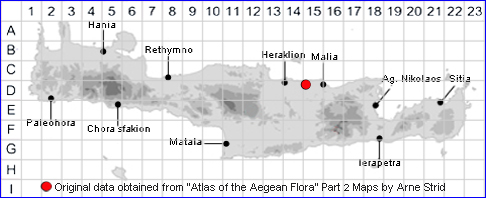
SPECIES DESCRIPTION
LIMONIUM ELAPHONISICUM
Including:- Limonium chersonesum
Family and Genus:- See- PLUMBAGINACEAE
Common Names:- None
Homotypic Synonyms:- None
Meaning:- Limonium (Gr) Meadow-plant. A name used by the Greek physician
and botanist Dioscorides.
Elaphonisicum (L) From the area of Elafonissi, west Crete
General description:- Glabrous perennial with a stout, branched woody stock,
forming loose tufts.
Stems:-
1) Erect, 20-30 cm, slender and flexuous, sparingly branched, with few sterile
branches.
Leaves:-
1) Basal, 15-30 x 3-5 mm, oblanceolate-spathulate, V-shaped in cross-section, 1-
veined. Greyish-green, with an acute or mucronate, often recurved apex.
Flowers:-
1) Spikes, lax and slender.
a) spikelets, appressed to the axis,1-flowered.
2) Inner bracts, 8-9 mm, ±; 3-coloured.
3) Calyx, 8-8.5 mm, narrowly, infundibuliform, densely tomentose in the lower half.
4) Corolla bluish.
Habitat:- Sandy beaches and dunes with small outcrops of limestone or
conglomerate. 0-40 m.
Distribution:- Cretan endemic. Confined to the southwestern coast of Crete,
between Cape Elafonisos and Cape Krios
Flowering time:- May-June.
Photos by:- Fotis Samaritakis


~~~~~~~~~~~~~~~~~~~~~~~~~~~~~~~~~~~~~~~~~~~~~~~~~~~~
LIMONIUM CHERSONESUM Back to Top
Homotypic Synonyms:-
Meaning:- Chersonesum (L) The epithet refers to Chersonesus, the old name of
the city Hersonissos.
Resembling Limonium elaphonisicum, but differering in the following characters:
1) Spikelets, more densely arranged.
2) Inner bracts, shorter.
Habitat:- Calcareous rocky coast.
Distribution:- Endemic, confined to the coast near Hersonissos in northeast Crete
Flowering time:- May-June.
Photos currently unavailable